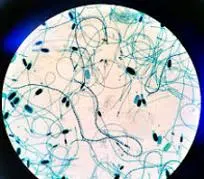The notion of cyanobacteria is not part of the dictionary of the Royal Spanish Academy ( RAE ).
It is important to know, first of all, what the etymological origin of the term at hand is. Specifically, we can determine that it is a neologism that appeared in the 20th century. This was formed from the sum of two clearly delimited components:
-The Greek word “kianos”, which can be translated as “dark blue”.
-The Latin noun “bacterium”, which derives from Greek and is used to define “microorganisms”.
The concept refers to a bacteria that can carry out oxygenic photosynthesis .
 To understand what cyanobacteria are, therefore, we must understand what a bacteria is and what oxygenic photosynthesis consists of. A bacteria is called a microorganism that has a single cell (it is unicellular ) whose nucleus is not differentiated. Oxygenic photosynthesis , for its part, is a type of photosynthesis: the process that allows organic substances to be synthesized from inorganic substances, using the energy provided by sunlight. In the specific case of oxygenic photosynthesis, water is the substance that provides electrons and develops the release of oxygen as a byproduct.
To understand what cyanobacteria are, therefore, we must understand what a bacteria is and what oxygenic photosynthesis consists of. A bacteria is called a microorganism that has a single cell (it is unicellular ) whose nucleus is not differentiated. Oxygenic photosynthesis , for its part, is a type of photosynthesis: the process that allows organic substances to be synthesized from inorganic substances, using the energy provided by sunlight. In the specific case of oxygenic photosynthesis, water is the substance that provides electrons and develops the release of oxygen as a byproduct.
Cyanobacteria constitute a phylum within the domain of bacteria . They are the only prokaryotic organisms that develop this type of photosynthesis . It should be noted that, in the past, these beings were known as cyanophycean algae , cyanophyte algae or blue-green algae . However, when the difference between eukaryotic cells and prokaryotic cells was discovered, the idea of cyanobacteria began to prevail.
The cells of cyanobacteria are usually larger than the cells of other bacteria. Its ability to develop oxygenic photosynthesis was vital in the evolution of the biosphere : with the appearance of cyanobacteria, which take hydrogen from water and release oxygen, the Earth's atmosphere began to become populated with this gas. In this way, cyanobacteria contributed to the appearance of aerobic metabolisms.
In addition to all of the above, we cannot ignore another series of important characteristics of cyanobacteria, such as the following:
-The habitats they prefer are those that have dead trunks, where there are tree barks, where there are humid soils...Hence, lakes and lagoons are a perfect habitat for them. Despite that, we cannot ignore that there are others that can be found in oceans.
-Another of its main peculiarities is that they can be found both in places with low temperatures and in others with very high temperatures.
-They move lightly.
-It so happens that there are some cyanobacteria that, by producing toxins, can poison animals that drink the water in which they are found or that reside in their same habitat.
-They reproduce through the fragmentation of the filaments.
-As far as asexual reproduction is concerned, we can highlight that it is vegetative.
